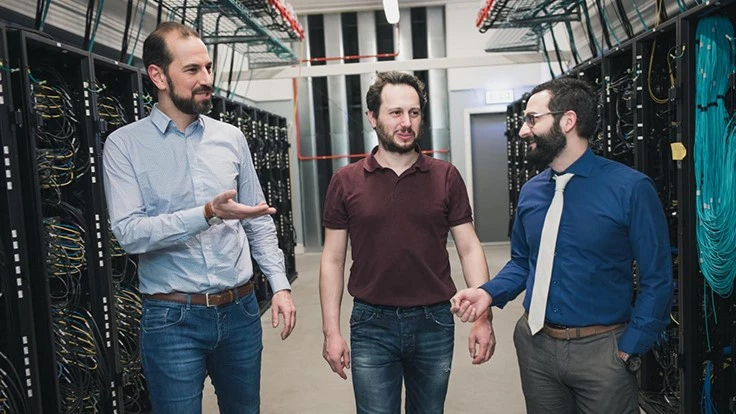
Photo credit: Anna Nilsen
Researchers at Linköping University have developed a theoretical model that enables simulations for showing what happens in hard cutting materials as they degrade. The model will enable manufacturing industry to save both time and money.
Titanium-aluminium nitride is a ceramic material commonly used as coating for metal cutting tools. With the aid of a titanium-aluminium nitride thin film, the cutting edge of a coated tool becomes harder, and the lifetime of the tool longer. A very particular feature of the coated surface is that it becomes even harder during the cutting process, a phenomenon that is known as age hardening.
Kostas Sarakinos, associate professor in materials science at Linköping University, describes the material as a workhorse in manufacturing industry.
The alloy is, however, sensitive to high temperature. A few minutes of cutting operation in a truly hard material subjects the cutting edge of the tool to such a high pressure that it is heated to 900° or above. At temperatures up to 700°, the material is unharmed, but it starts to degrade at higher temperatures. The edge softens and loses sharpness.
Until now, no one has been able to determine what happens at the atomic level inside the thin film during the cutting process. It has only been possible to partially simulate the properties of the complex combination of titanium, aluminium and nitrogen, and it has not been possible to draw any conclusions from the results.
Georgios Almyras, who previously worked as a post-doctoral researcher at the Nanoscale Engineering Division and has now moved to Ericsson, Davide Sangiovanni of the Division of Theoretical Physics, and Kostas Sarakinos, head of the Nanoscale Engineering Division, have after four years' work developed a reliable theoretical model that can be used to show exactly what happens in the material, with picosecond time resolution. They have used the newly developed model to simulate events in the material, showing which atoms are displaced and the consequences this has for the properties.
"This also means that we can develop strategies to stop the degradation, such as alloying the materials or creating specially-designed nanostructures," says Davide Sangiovanni.
Their theoretical model calculates the forces between the atoms in the material. The model is based on a previously known method that has been successfully used in simple material systems. Complex combinations of materials, however, require time-demanding calculations that are only possible in a supercomputer. The research group from LiU has optimized these calculations by implementing machine learning algorithms which the predecessors of artificial intelligence.
The supercomputer at the National Supercomputer Centre at LiU has then been used for calculations of around 40 alloys of the three elements titanium, aluminium och nitrogen, while looking at several properties of the material. The scientists have then compared the results from the calculations with the known properties of the materials.
"The agreement is very good," says Kostas Sarakinos. "It's important that we have calculated also properties that we know, because then we can be sure that the calculations and predictions of the model are reliable."
The researchers hope that the method will be useful for companies in the manufacturing industry, such as Sandvik, ABB, Seco Tools, etc., which could save a lot of money by developing tools with greater hardness and resistance to wear. These are companies with which the LiU researchers have long-term collaboration agreements.
"We can now for the first time carry out large-scale classical simulations of atomic structures in one of the material systems most commonly used for metal cutting and forming. The simulations can consider resistance to heat or nanostructures, and they may provide important insight into how the atoms move. The results will help us avoid, or at least delay, degradation of the material,” says Kostas Sarakinos.
Latest from Today's Medical Developments
- HEULE’s DL2 tooling
- Application Park shows off diverse robotics applications
- Join our editors for a look at the manufacturing industry in 2025
- Surface Roughness, Texture, and Tribology Short Course
- There’s still time to register for our January 22 additive manufacturing webinar!
- EMO: Made for game changers
- Thomson’s encoder options for stepper motor linear actuator online selection tool
- BD boosts US manufacturing of critical medical devices





